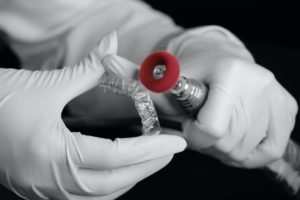Perhaps you are considering purchasing hearing aids to help with your hearing loss, but you’re confused with so many options available. That’s normal, and it’s nothing to be ashamed of. But you can be successful in purchasing hearing aids if you understand the different types of hearing aids available and you consult with a hearing professional. To that end we will list the most common types of hearing aids on the market as a means to get you started. Just remember to have your hearing tested and your needs assessed before you invest in any hearing aid device.
Conductive or Amplifying
The first category breakdown for hearing aids designates whether they are conductive or amplifying. Most standard hearing aids on the market are considered amplifying in that they separate out frequencies the user has trouble hearing and amplifies them. Typically the amplifying hearing aid is a temporary device which is battery operated. It is used during the day and taken out at night. Some amplification devices are intended for extended use and can remain in the ear for up to six months.
Must Read: How Do Hearing Aids Work?
Conductive hearing aids are completely different because they are treating a different problem. Conductive hearing loss means that sound waves that enter the ear canal are interrupted and prevented from reaching the nerve endings. This can be caused by a variety of things including trauma, disease, or genetic malfunction. To get around this interruption, the conductive hearing aid bypasses the inner ear entirely and utilizes the skull bones to perform the same function.
With a conductive hearing device a titanium prosthetic is implanted into the skull just behind the ear. Once skull tissue and bone grow up around the prosthesis an external hearing device can then be attached. The external device “hears” the sounds, translates them into electric impulses which are then sent to the prosthesis. The prosthesis receives the electrical signals and causes the skull bones to vibrate, thus activating the nerve endings in the ear and transmitting signals to the brain. This type of hearing aid is often referred to as a bone anchored hearing aid.
Different Types of Amplifying Devices
The most common amplifying hearing aid is known as in-the-ear. It is what most of us think of when we talk about hearing aids. It is a small, fitted module that sits snugly up against the opening of the ear canal. This type of device comes in a variety of shapes including full shell, half shell, and so on. The size and shape of your in-the-ear hearing aid will depend on your comfort level and the severity of your hearing loss.
A second type of amplifying device is known as completely-in-the-canal. This type of hearing aid is significantly smaller and can be placed deep enough into the ear canal that it cannot be readily seen. Not everyone can use these devices if their ear canal is too small, or they are prone to ear infections. These types of hearing aids also cannot be worn by those suffering from diabetes. Completely-in-the-canal hearing aids are designed for people with minor to moderate hearing loss.
Also See: How do I get my ears to stop ringing
The third type of amplifying device is known as behind-the-ear. This device utilizes an external unit with an internal receiver. The external unit fits snugly behind the ear and is generally covered up by the hair. From the top protrudes a clear plastic tube which is connected to a receiver that sits just inside the ear canal. The receiver can be seen by the naked eye, but if others don’t know it’s there, they most likely will not notice it. This type of hearing aid is designed for individuals with mild to moderate hearing loss.
There is a specific type of behind the ear hearing aid made for those suffering from severe hearing loss. It is known as a receiver-in-the-ear model. It works exactly the same way except for the fact that the receiver is situated much more deeply in the ear canal. This requires a slightly longer tube and a slightly smaller receiver, but it is quite effective for those who need it.
Choosing the Type of Hearing Aid for You
The only way to correctly determine what is the best type of hearing aid for you is to consult with a hearing professional. He will need to determine the severity of your hearing loss, your typical day-to-day environment, what types of noises are bothersome to you, and a host of other factors. He will also have to measure your ears to determine how to best fit the hearing aid for your needs.
Professionals recommend that you do not try to assess these things on your own, because of the likelihood that you will spend thousands of dollars on a hearing aid that will not work for you. On the other hand, a certified professional can almost guarantee you’ll receive the right type of hearing aid at the best price.



















